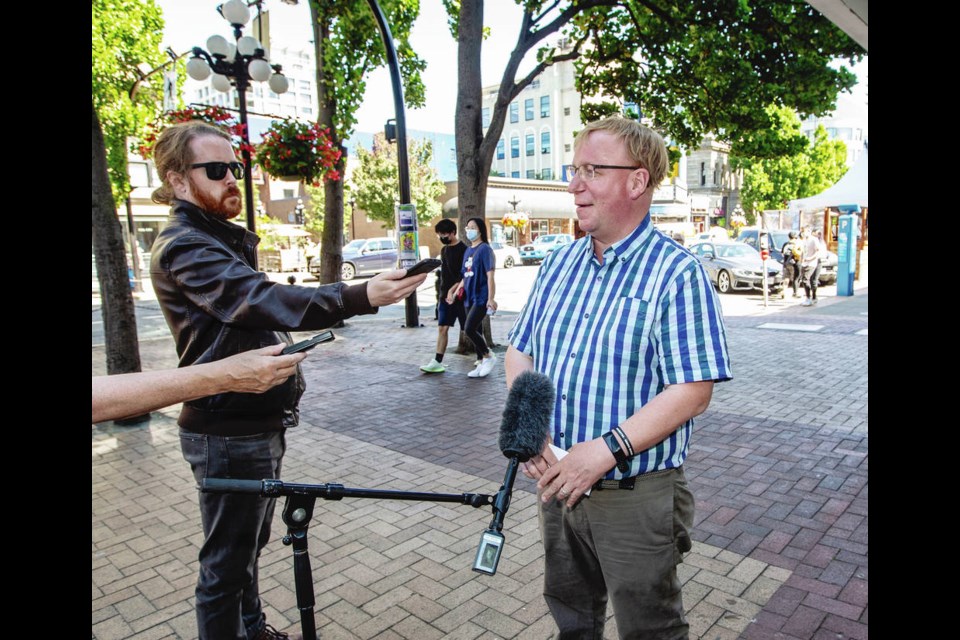The first Clipper ferry since the pandemic began will pull into Victoria Harbour on Sept. 17 now that Canada is opening many marine entry points.
Among private-sector ferries serving the Island, only the Clipper has announced resumption of service to Victoria. The Coho ferry and the Sidney-Anacortes ferry will not be running until 2022.
Even so, Paul Nursey, chief executive of Destination Greater Victoria, is buoyed by the news that marine borders for ferries will be open as of Sept. 7. “It is going to make a huge difference for the operators and for us.”
All three services are critical players in Greater Victoria’s tourism sector, which has historically relied on Americans pouring across the border to fill hotels, visit attractions, experience adventure tourism, take home souvenirs and go to restaurants.
The Clipper will be carrying American permanent residents who have been double vaccinated and have proof of a recent negative COVID test. Canadians won’t be travelling south to Seattle because the U.S. border remains closed to marine travel by non-Americans.
The ferry will operate its typical shoulder-season sailings of one round-trip per day, starting with a 7:30 a.m. departure out of Seattle and leaving Victoria at 5 p.m.
It will sail four days a week on Fridays, Saturdays, Sundays and Mondays, David Gudgel, chief executive of Clipper Navigation, said Tuesday. “We are just stepping right back into our normally scheduled service.”
Plans for a single round trip per day are based on company projections, he said. “We will see how pre-bookings go.”
Early September follows what is normally the peak tourism season. “We are anticipating that there is still a market around the weekend trips and day trips,” he said.
A visit to Victoria will not be a spur-of-the-moment decision because of pre-planning required to meet Canadian rules, raising the question of how many Americans will come to Victoria this year.
The Clipper will likely resume service with a scaled-down staff.
“I think the biggest issue here is that we are able to put our teams and our crews back to work,” Gudgel said, noting that their unemployment benefits are running out in early September. “The timing is critical and we are very happy that we are able to provide our folks with employment.”
The Clipper has a capacity of 579 passengers but normally a maximum of 535 is carried, Gudgel said. In the shoulder season, it would be rare to see more than 350 and he’s anticipating fewer numbers due to Canada’s health and safety requirements.
The Canada Border Services Agency announced Tuesday that it would resume operations at a number of small marine entry sites, airports and ferry terminals in coming days and weeks.
These include Belleville and Blackball terminals in Victoria Harbour and the Washington State Ferry Terminal in Sidney.
Ryan Burles, president of Black Ball Ferry Line, which operates the Coho between Port Angeles and Victoria, said that although the company is happy to learn that the Victoria terminal is being opened, it will not start operations until the U.S. border opens.
“For us to survive, we need that south border to open up so that Canadians can head south.”
Ian Sterling, spokesman for Washington State Ferries, said, “We are not intending to be back until at least some time in 2022 now.” He speculated the ferry may return in spring. Next month’s marine border opening in Canada, “is too little too late unfortunately” for this year, he said.
Challenges include lining up staff during a time of an ongoing shortage of mariners, an issue B.C. Ferries is facing as well.
“We are really not trying to expand service at this time. We are just trying to maintain what we have,” Sterling said.
Victoria Mayor Lisa Helps and Bruce Williams, Greater Victoria Chamber of Commerce chief executive, were surprised when air and land borders were opened by Canada on Aug. 9 but ferry borders remained shut.
Nursey said it was “very upsetting” to learn that the Belleville Terminal had lost its status as an international port of entry into Canada and that it could take up to a year to get it reinstated.
The border closure for ferries prompted local politicians, business groups and other stakeholders to work together to lobby the federal government. “Everyone jumped in,” Nursey said.
Opening the Canadian border is important for local hotels, which have proved they can operate safely, he said.
Even if just a trickle of U.S. visitors come in, this will help the sector as summer vacation for Canadians winds down. About 85 per cent of Clipper’s business comes from U.S. passengers, he said.
Tuesday’s announcement means that destination marketing from Greater Victoria into Washington state can be carried out in a staged and orderly manner, Nursey said. “We have a date now. We can work with that.”
Greater Victoria Chamber of Commerce chief executive Bruce Williams said,“Our marine border is a vital link for our region and we’re thankful the Canada Border Service Agency has found the capacity to staff ferry terminals in the Inner Harbour as of Sept. 7.”
Victoria Mayor Lisa Helps said the Belleville Terminal is an important entry way to the region and a key engine of the region’s economy.
“The Coho and Clipper are critical links for Victorians with our neighbours to the south and we look forward to this long-standing border crossing being reopened.”



